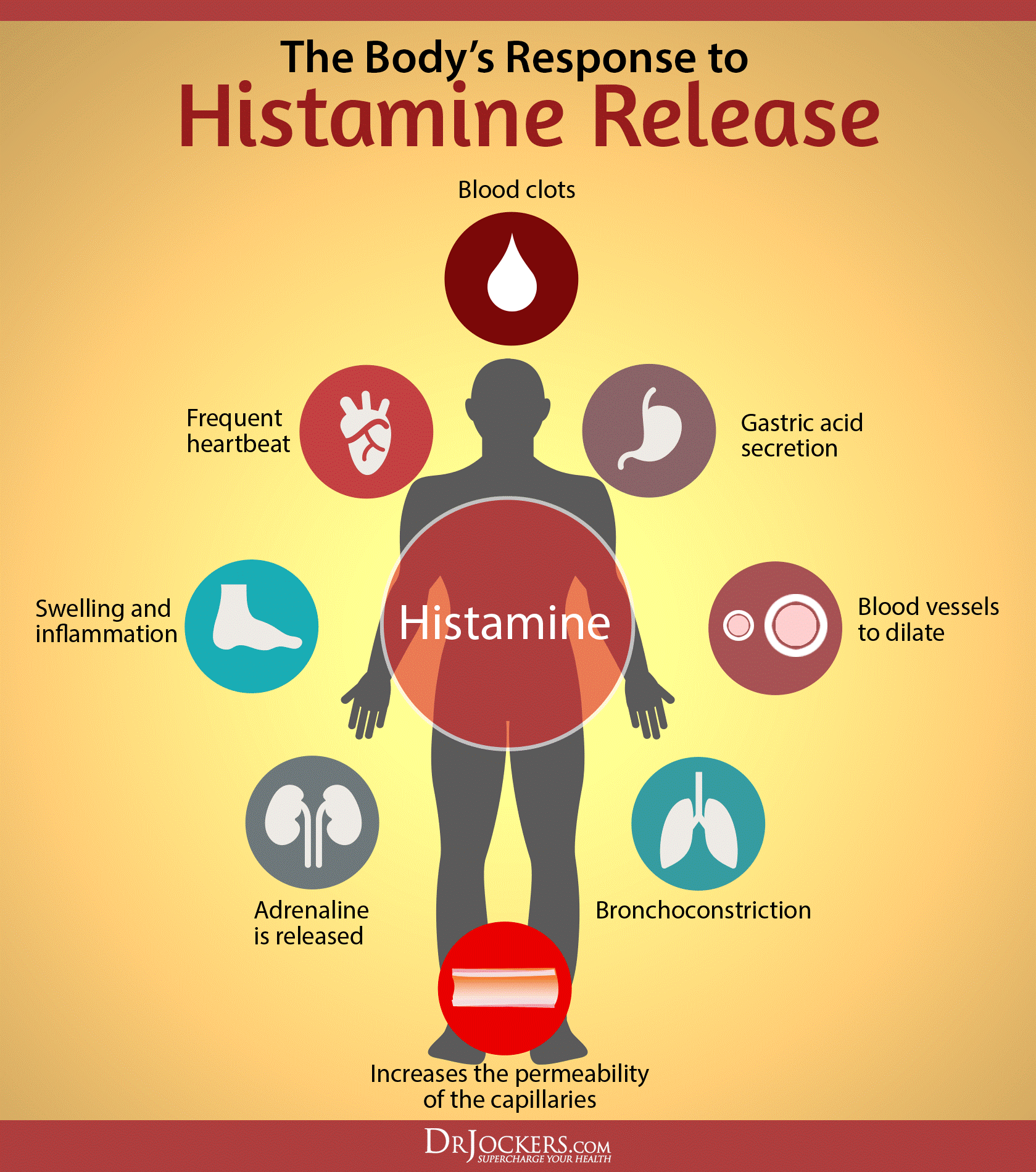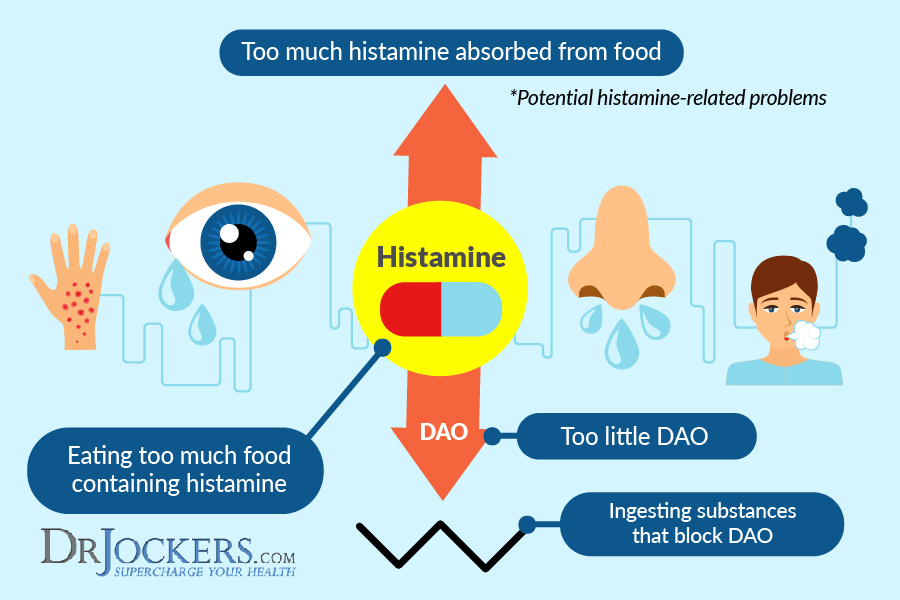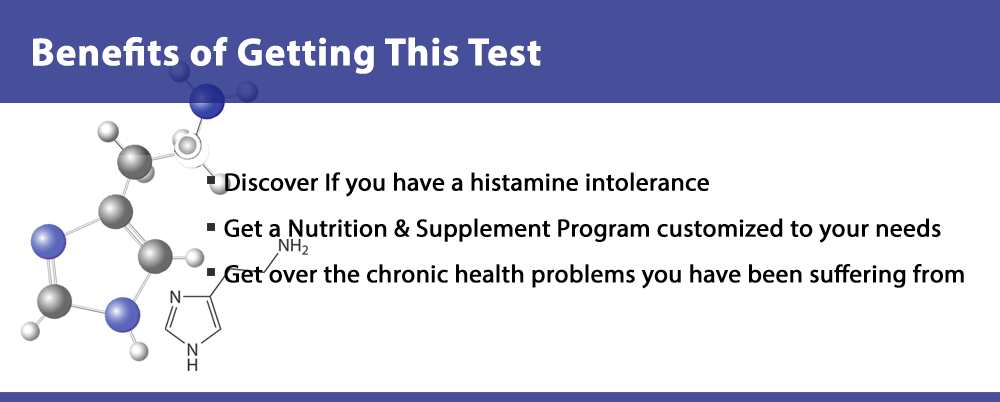![]()
Customer Service: 847.222.9546

WHAT IS HISTAMINE?
Histamine is an important neurotransmitter and immune messenger molecule. It is involved in processes involving hydrochloric acid secretion for digestion, triaging water reserves to key areas of the body and the inflammatory response (1).
One of the major effects of histamine is causing the blood vessels to swell and dilate. When the body senses that it is threatened it will secrete higher amounts of histamine. This allows the white blood cells to quickly move through the blood stream and find the potential threat or infection. This is an important component to a healthy immune response.

WHEN DOES HISTAMINE BECOME A PROBLEM?
Histamine only becomes a problem when we have metabolic disturbances that do not allow us to effectively metabolize histamine properly. When histamine is formed it is broken down by specific enzymes. In the central nervous system it is metabolized by histamine N-methyltransferase (HMT), while in the digestive tract it is broken down by diamine oxidase (DAO).
The experts state that DAO is the major enzyme involved in histamine metabolism (2). The enzyme converts the histamine into imidazole acetaldehyde which does not trigger any sort of reaction in the body. DAO is responsible for ensuring a steady histamine level required for the balance of numerous chemical reactions taking place in the body.
Some individuals have altered DAO production due to a number of different factors including (3):

WHO HAS HISTAMINE INTOLERANCE?
According to available research, histamine intolerance manifests in approximately 3% of the population (6). In up to 20% of these cases the symptoms occur mostly when histamine containing foods are used in combination with DAO inhibitors such as alcohol. Approximately 80% of individuals with histamine intolerance are women and most of them are over 40 (7).
The three biggest factors involved with histamine intolerance include leaky gut syndrome or related disorders such as Crohn’s disease, Irritable bowel, celiac, gluten sensitivity, etc (8). The second factor is a genetic polymorphism with the DAO enzyme. Heavy alcohol and/or medication usage is another strong risk factor.

DIAGNOSING HISTAMINE INTOLERANCE
This is a challenging condition to diagnose for a number of reasons. The first is that there are so many popular foods, many of which are considered health foods that are high in histamines. Also, some individuals have a unique gut flora that is producing high histamine levels.
Most doctors are not familiar with histamine intolerance and never consider this as a contributing factor in the individual’s health challenges. In fact, many physicians including myself, typically recommend a diet high in histamine containing foods. This includes fermented foods which have incredible health benefits for those with adequate histamine metabolism.
As a clinician, I have learned that when individuals react very poorly to fermented foods it is a sign of histamine intolerance. Most people respond very well to small amounts and gradually increasing levels of fermented foods. Individuals with histamine intolerances often break out with hives, eczema, rashes, puffy eyes, headaches, etc.

COMMON SYMPTOMS OF HISTAMINE INTOLERANCE INCLUDE (9, 10):
- Headaches/Migraines
- Difficulty falling asleep, easily arousal
- Hypertension
- Vertigo or Dizziness
- Arrhythmia, or accelerated heart rate
- Difficulty regulating body temperature
- Anxiety
- Nausea, Vomiting
- Abdominal cramps
- Flushing
- Nasal Congestion, Sneezing, Difficulty Breathing
- Abnormal Menstrual Cycle
- Hives
- Fatigue
- Tissue swelling
Histamines travel throughout the bloodstream and therefore can effect the gut, lungs, skin, brain and entire cardiovascular system. This is why there are such a wide array of health problems associated with it and it is quite challenging to pinpoint and diagnose if you are not aware of the condition.
TESTING FOR HISTAMINE INTOLERANCE
We test for histamine, DAO, the DAO:Histamine ratio, Zonulin and Lipopolysaccharide (LPS) levels. You can see a sample copy of this test here
The official name of this test is the Advanced Intestinal Barrier Assessment (or AIBA) as it looks deeply into how the bodies intestinal barrier is holding up. Here are the details of the test.
The DAO: Histamine Ratio
This ratio helps detect subtle imbalances between histamine and DAO levels. Even if the DAO enzyme level is normal when histamine is high, symptoms can occur. A low ratio indicates that there may not be enough of the DAO enzyme relative to the amount of histamine in your body.
Zonulin
This compound plays an important role in the opening of small intestine tight junctions. The loss of gut wall integrity during conditions such sepsis might be pivotal and has been described in various experiments involving human studies.
Increased levels of zonulin could also be demonstrated in diseases associated with increased intestinal inflammation, such as celiac disease and type 1 diabetes. Therefore, we measure this molecule as a non-invasive marker of gut wall integrity.
Based on the results of this test a specific nutrition and supplementation program will be designed to optimize cofactors and DAO function and modulate histamine levels.
LPS
This compound is produced from bacterial cell walls and initiates an inflammatory response in the body. LPS can be used to detect a dysregulated cell membrane making it a marker of a transcellular leaky gut. Since there will always be some LPS present, there should, in turn, be some immune response recorded.
High LPS Levels
An elevated lipopolysaccharide (LPS) reaction indicates intestinal permeability or “leaky gut.” Lipopolysaccharide is the immunogenic portion, as well as the major constituent, of the outer cell membrane of gram-negative bacteria. LPS is a bacterial endotoxin made by bacteria in the body.
When lipopolysaccharides are high in the blood, it means they are passing not only between intestinal cells, but also directly through the cells, potentially causing neuroinflammation and brain injury. When LPS is absorbed into systemic circulation it can elicit a strong immune response.
Elevated levels may be associated with bacterial infection, food sensitivities, chronic inflammation, autoimmune conditions, digestive disorders, and neurological conditions.
Low LPS Levels
When a patient tests on the low-end of the spectrum for an immune response for LPS IgG, LPS IgA and LPS IgM, this is a good indication that their immune system is not functioning as it should.
When there is a low response this means immunoglobulin levels go down and bacterial levels stay up. Ongoing gut pain and flairs persist, as patients can no longer fight infections as they should and the higher level of bacteria in the gut causes irritation. Conditions associated with low LPS antibodies are IBS, Crohn’s Disease and Colitis.

Total Cost: $379.00
If you live in New York or New Jersey, some lab testing may not be able to be completed. Please contact our team at (847) 222-9546 to verify that this request can be fulfilled.


Fortunately, because of the many thousands of newsletter readers and social media followers, my team has been able to network with a great lab distributor and get the best possible pricing for everyone.
The retail value (using market value and insurance based rates) is highly inflated and driving up the cost of health care. This is the old, archaic method that many people are still using and paying way more for insurance and co-pays than they really should be.
Many intelligent people are saving insurance premium dollars and turning to pay by order labs such as DirectLabs and others. These skip the middle man (doctors’ visits) and cut down costs for the patient.

If the test requires blood work you can take your kit to any local lab and have the trained professional take your blood and fill out the kit and send it in the mail.
Urine and blood prick tests can all be done in the comfort of your home and sent into the lab with the mailing slip in your kit. All instructions will be sent to you with the kit. It is a very simple process that most anyone can figure out. The lab also has a customer service phone # if any help is needed.


